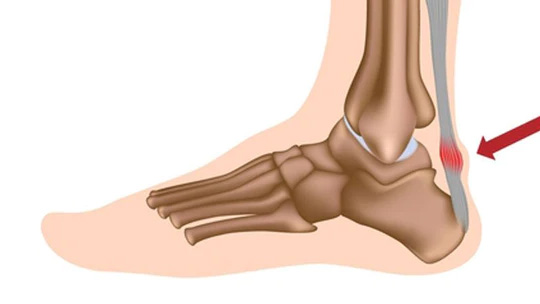Achilles Tendonitis
When the Achilles tendon, the tendon that connects your calf muscle to your heel bone, becomes swollen, inflamed, and painful at the heel.
Achilles Tendonitis is most common among active younger teenagers and adults. Walking, running, playing sports, or other athletics that put stress on the Achilles Tendon causes a susceptibility to Achilles Tendonitis. Middle aged and the elderly are also at risk for developing Achilles tendonitis as a result of a having a heel spur that can irritate the Achilles Tendon and cause irritation, pain, and swelling.
WHAT CAUSES ACHILLES TENDONITIS?
Possible causes of Achilles Tendonitis include overuse of the Achilles Tendon through continual athletic activity and Heel Spurs. Possible causes include:
- Excessive walking or running
- Athletics that involve putting a large amount of stress on the Achilles tendon such as: basketball, football, and soccer.
- Repeated jumping
- A sudden increase in activity; either frequency or intensity
- Lack of stretching, or improper stretching, of the calf muscles
- A Heel Spur
HOW DO I KNOW IF I HAVE ACHILLES TENDONITIS?
WHAT ARE THE SYMPTOMS OF ACHILLES TENDONITIS?
Pain and stiffness in the heel and along the tendon when walking, running, during the first steps in the morning, or after a night of sleep are the most common symptoms of Achilles tendonitis.
Other symptoms include:
- Red, swollen skin over the tendon that is warm to the touch.
- Difficulty standing up on one toe.
- Achilles Tendon is painful to touch or move.
HOW IS ACHILLES TENDONITIS DIAGNOSED?
A physician will conduct a physical examination that will discover if there is any of the following:
- Tenderness along the tendon
- Pain in the area of the tendon
- Difficulty or pain when standing on your toes
X-rays might be taken to discover if there are any other problems. An MRI scan may also be done if your physician is concerned about a tear in the Achilles tendon, or if surgery may be considered.
WHAT CAN I DO FROM HOME FOR ACHILLES TENDONITIS?
WHAT CAN I DO TO PREVENT ACHILLES TENDONITIS?
Limiting activities that put stress on the Achilles Tendon is the best way to prevent Achilles Tendonitis from occurring. Maintaining the strength and the flexibility of the Achilles Tendon will also help to prevent and relieve symptoms, as well as warming-up slowly before starting physical activity.
If you are currently suffering from Achilles Tendonitis, activity lifestyle changes can help to improve the symptoms. However, it is possible that after you return to the activities that have contributed or caused the Achilles Tendonitis, symptoms could return. In which case you may be suffering from chronic Achilles Tendonitis.
WHAT TREATMENTS CAN I DO FROM HOME FOR ACHILLES TENDONITIS?
- Rest – Get off your injured foot as soon as possible. Relieving weight and pressure will help your foot heal faster and avoid further injury.
- Ice – Rest or wrap your injured foot with ice as soon as possible. Ice helps prevent swelling and promotes faster healing time. Wrap the ice in a towel to avoid putting ice directly on the skin.
- Compress – Immobilize the injured foot with a bandage or ankle brace. This gives your ankle stability and protects it from further injury. Make sure you do not wrap your foot or ankle too tightly and cut off the blood supply to your foot.
- Elevate – Make sure you keep your foot elevated as this will also help to minimize swelling. It’s best if you can elevate your foot to the level of your heart.
- Take anti-inflammatory and pain medication
- Mild stretching exercises. This will keep your muscles and tendons from stiffening up while healing.
WHEN SHOULD I SEE A DOCTOR FOR ACHILLES TENDONITIS?
You should see your physician if you have pain in the heel or around the Achilles tendon that worsens with activity, or manifests itself when you first wake in the morning and begin to walk.
TREATMENTS YOUR DOCTOR MAY RECOMMEND FOR ACHILLES TENDONITIS
There are several treatments available for relief of Achilles Tendonitis, including:
- Decreasing or stopping activity that is causing you pain
- Walking or running on a smoother surface
- Switching physical activity to swimming, biking, or another activity that puts less stress on the Achilles Tendon.
- Taking NSAIDs (Non-Steroidal Anti-Inflammatory Drugs) to reduce pain and inflammation
- Wear shoes with good support and cushion that are softer in the area around the heel
- Apply ice to the Achilles Tendon three times a day for 15 minutes; remove the ice if the area becomes numb
- Use a heel cup in your shoes to reduce the pressure on the heels by shock absorption
- Use of a boot to immobilize the heel and tendon so swelling can go down
- Use of a small heel lift to take some pressure off the tendon
If these treatments don’t work, the physician may suggest the following:
- Extracorporeal shock wave therapy (ESWT)
- Surgery to remove a heel spur
- Surgery to remove inflamed tissue

